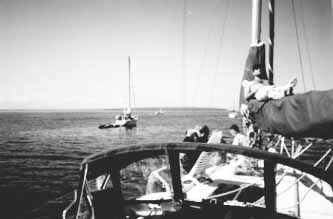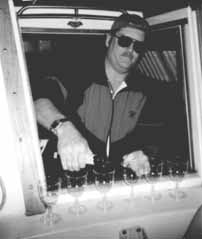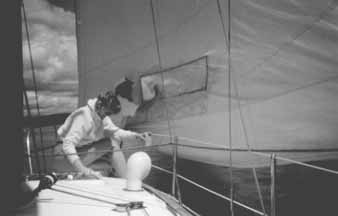
Floating Leadership Styles
by Captain Joan Gilmore
Teaching on the water is a little different from teaching in other settings. For one thing, it’s one of the only places you truly have a “captive” audience. For another, if someone doesn’t like your style, they will have a hard time walking away - without getting themselves very wet!
But, even though the audience is “captive,” the experience still needs to be as enjoyable as possible. Students won’t show up for another session if they’re scared or uncomfortable. But, since they are “captives” for the space of time they are on the boat, they always offer their full attention. The only distractions on the water are things that ought to disrupt the lesson, such as a fast approaching storm or fast approaching boat! So, teaching on a boat is easy. Not only that, but most people realize that the instructor is the only one who can save their lives in an emergency, and, especially for beginning classes, the only one who can get everyone back to the dock. So not only is that audience captive, they’re respectful!
So how does one handle this “ideal’ teaching situation? Several ways, depending on who the students are. The first way:
Empowerment - Empowerment is teaching students enough by explanation and example to let them start making decisions by themselves very early on in the learning process. For most adults, this speeds up learning, as students are forced to process everything they have learned - on the spot. Part of the point of Empowerment is to let students make mistakes in the “classroom” setting with the instructor onboard. The more mistakes made, actually, the better, as students can see why things didn’t work, why the recommended (taught) procedure is better, and will remember the correct way. The right way to do things will be embedded in their brains along with a vivid personal memory of the consequence of doing things the wrong way.
 |
| Crew carefully assesses conditions - as they synthesize their skills. |
If the “mistake” made doesn’t harm the crew and doesn’t harm the boat, it’s a positive learning experience.
If students attempt to learn on a boat where everything goes right - which it should on a typical captained charter - they will learn very little, although they’ll have a pleasant experience. For this reason, I allow students to make mistakes in a controlled setting - the more the better - to speed up and “embed” the learning process.
Allowing students to do things the wrong way and letting them see the results and discuss those results will save them from making that mistake on their own - where they haven’t learned how to handle it or even why it happened.
Of course, this learning-by-erring style needs to be tempered by lots of successes by the students, so the instructor needs to intervene with enough helpful hints along the way so that students don’t become discouraged by making too many mistakes.
People don’t learn to sail until they are able to make decisions for themselves. In sailing there are many right ways of doing things - all dependent on the conditions - so a primary quality of a good skipper is judgment. Varying conditions and problem-solving all hone good judgment.
Obviously, during emergencies the captain needs to be in careful control. Once, an alcohol stove flared up during a liveaboard cruising course. I asked the two students present what they recommended. One student recommended the proper procedure - shutting the lid on the stove - so I let him do it, even though another student had another (less effective) suggestion - smothering it with a tea towel. Since the debate was beginning to get lengthy, (too lengthy for safety, under the circumstances,) I had to pull rank and let the proper solution prevail, without benefit of letting the students experience the results of each method of attack.
The captain is still in charge - but it’s great to let students solve things in the “lab” of a sailing classroom.
During that same cruising course we discovered that our chartered boat had non-functioning wind instruments and depth sounder. In fact, none of the boat’s instruments worked, including the compass! We took a heavy pot lid from the galley, (at a student’s suggestion,) tied it to the end of a cord and used it to sound the depths. Since the compass didn’t work, we lined up points of land on nearby islands to nail our approximate position on the chart.
All these things taught the students so many new skills that they accused me
of ordering the broken depth sounder and compass, and even starting that fire in the galley!
 |
| Empowered crewmember Mark Montillon shifts “companionway” to a new paradigm. |
Kid’s Style - This is a “step and repeat” style that works very well for kids, because everything gets broken down into steps, and repetition is a main feature of the style. Aspects of this style can be very effective for adults, too.
Kids need to be shown exactly how to do something - say tying a bowline. Since kids are usually fast learners and very impressionable, it’s important that you do it exactly right the first time, and it helps to have catch phrases for each step so that no steps in the procedure are left out.
When showing how to hank on and raise a jib sail I explain, “First “tack on” the tack. Next “hank on” the hanks.” I clip the hanks to the forestay as I use the words. Next, I tell them to “Get a clew.” At this point, I let the bowline “bunny” go to work, popping out of its hole and racing around that tree.
So, the steps for the Kid’s method are:
1. Show them exactly how to do the task, using steps and catch phrases.
2. Have them do it while you watch and correct.
3. Have them do it by themselves, then come by and check it.
4. Have them show another kid how to do it.
Step 4 is important. If you tell them from the beginning that they will be teaching the next person, kids, being naturally responsible, are much more attentive.
The Empowerment style works best for adults who can synthesize skills, use mature judgment, and problem solve on the spot. People, however, need to be relaxed in order to problem solve on the spot. Being relaxed is also important for synthesizing information and for choosing between a variety of options based on an evaluation of current conditions.
The Empowerment style invites questions; the Kid’s style doesn’t. Sometimes, the Empowerment style can lead to long discussions and can ferret out misconceptions that students hold, that could cause them to get into danger in the future, if not explored and corrected.
 |
| Captain Joan (scrubbing jib) leads crew Lynn Gaardsmoe - by example. |
The Dictator style may be useful in an emergency, when things need to be done fast, in a certain order, and when the crew is required to participate in maneuvers that they don’t yet understand. Ironically, the Dictator style doesn’t work unless the crew trusts the captain and the captain trusts the crew. If not, and the crew is unwilling to follow orders, the captain may have to go for the Do-It-Yourself style: “Everybody go below! I’ll handle this storm!”
Obviously, the Dictator style and the Do-It-Yourself style don’t teach anybody anything. The Dictator style is a cooperative way to handle emergencies that the students haven’t learned about yet. And the Do-It-Yourself style is a tough way for the captain to handle emergencies that, since they have no part of it, the students will never learn to handle.
An easy way to learn in the empowerment mode is to watch another group on the water doing something wrong, and having the crew critique the situation, pointing out what’s being done wrong, and what could be improved. On a recent sailing trip, our crew watched a 35 foot boat with a raised jib try to raise their mainsail. Since the jib sail made the boat turn away from the wind, the main sail could not go up smoothly, as it made it impossible to keep the boat pointed into the wind. I wish I had that awkward scene on videotape to show students who ask, “Why can’t we put up the jib first?”
The Empowerment style invites questions, sometimes too many. It can be hard to get on to the next subject if someone in the class doesn’t “get it”. The Kid’s style doesn’t invite questions. It invites repetition. The Dictator style needs to stand by for an emergency. All these styles have their place and can be combined in a tailor-made way for whoever steps onboard and for whatever happens thereon. The more styles one has to choose from, the more methods of discovery one can offer to crew members.
Joan Gilmore is a U.S. Coast Guard licensed captain and co-owner of Northern Breezes Sailing School. For the past three summers she has been liveaboard captain and sailing instructor for crews of teenagers on a 43’ ketch on Lake Superior owned by the YMCA. This summer she is teaching adults Basic Keelboat on Lake Minnetonka and Bareboat Cruising on Lake Superior.